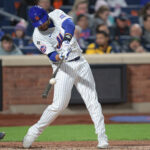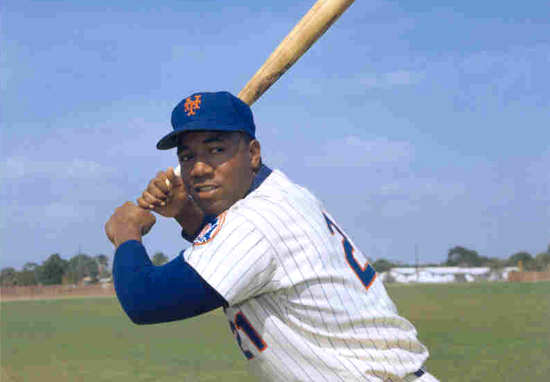
When he removed his Mets uniform for the final time he was our all-time leader in hits, runs, RBI’s, doubles and 2nd in batting average. There was no fanfare, no celebration of his achievements, no day honoring his accomplishments after a decade of playing in New York. Instead, he lumbered away, head down, disgraced, a beaten man.
He’s one of very few Mets who can call himself a two-time pennant winner. He had a direct impact on both the 69 and 73 season. Teammate Buddy Harrelson said of him, “Even if he was in a 0-for-20 slump, he was the guy you’d still want at-bat.” Tom Seaver was our first superstar. But this man was our first offensive superstar. He caught a fly ball off the bat of Davey Johnson and dropped to one knee, an image that remains one of the most iconic in team history.
He was never given a snazzy nickname like Doctor K, Nails, Kid, or The Franchise. Instead, we referred to him by his given name only: Cleon
Cleon Joseph Jones was born August 4, 1942 in Mobile, AL, the same birthplace as Hank Aaron. He’d wear number 21, the same as Roberto Clemente. His first Major League game was playing center field in the Polo Grounds, the same position patrolled by Willie Mays. And although Cleon was nowhere near the player these Hall of Famers were, it was okay. He was our legend.
Numerous players throughout history have been seemingly predestined for a career in the majors, be it the ability to throw a ball at 100 MPH with pinpoint accuracy, blinding speed or remarkable hand-eye coordination. Cleon was not one of them.
Whereas some burst on the scene, Cleon yo-yoed for several years. Wearing number 34, he made his major league debut on September 14, 1963. Manager Casey Stengel put the 21 year-old in as a defensive replacement for Duke Carmel. In what would be one of the final games ever played at the Polo Grounds, Cleon played CF. And like Moonlight Graham’s one inning, they never hit the ball anywhere near him. .
Cleon had 15 AB’s that September, getting just two hits for a forgettable .133 BA.
He spent all of the 1964 season with the AAA Buffalo Bisons. The next year, he made the team out of spring training. However, after one month and a meager .156 BA, he was once again demoted to Buffalo. Cleon was a late-season call-up and on September 22, 1965, in a 6-2 loss to Pittsburgh, he hit his first HR, a solo blast off of Bob Friend. Despite the dinger, however, he batted just .149, 11-for-74. The Mets finished in 10th place, 50-112, 47 GB.
In 1966, Cleon was named the Mets everyday starting center fielder. Not because of a overwhelmingly solid performance, but largely due to the fact the Mets had little else. In his first full season, Cleon improved. .275-8-57 and 16 steals. His performance earned him fourth place in Rookie of the Year voting.
There was optimism coming into 1967. For the first time, the Mets had NOT lost 100 games the previous season and two rookie pitchers, Tom Seaver and Jerry Koosman, showed lots of potential. However, Cleon backpedaled. His BA dipped to a disappointing .247 and he ended up in a CF platoon with Larry Stahl. The team as a whole also backtracked, once again losing over 100 times that year. Six seasons, five of which saw more than 100 losses. Would things ever improve?
In 1968, Cleon was shifted to LF to make room for a newly acquired CFer. Tommie Agee had been AL Rookie of the Year in 1966 and was a childhood friend of Cleon. Management also brought in a new manager, much loved former Brooklyn Dodger Gil Hodges. Despite Hodges, Agee and defending NL ROY Tom Seaver, Cleon’s struggles returned. Six weeks into the season he was hitting just .205 and found himself in a platoon again, this time with Art Shamsky.
Then it happened. Something clicked.
On May 18, Cleon went 3-for-4 with a home run, two RBI’s and a pair of runs scored. He started to hit. And there was no stopping him. On July 16th against the Phillies at Connie Mack Stadium, number 21 went 4-for-6 with 3 RBI’s, 1 RS and played all 3 OF positions. He ended the season batting .297, fourth best in the NL. Next up: 1969. And our left fielder was in the center of it all.
Although he notoriously started slow and was always a streaky hitter, Cleon was 26 and coming into his prime. He kicked butt from Opening Day and never looked back. By the All-Star Break he was batting .341 with 10 HR’s and 56 RBI’s, good enough to earn a starting spot in the Mid-Summer Classic along with the likes of Aaron, Johnny Bench, Willie McCovey and future teammate Felix Millan. Cleon went 2-for-4 with two runs scored against the best the American League had.
By that summer Mets fans were beginning to think the unthinkable. The team that had lost 737 games in seven seasons actually had a good chance to finish .500. However, Gil Hodges, a man who knew a lot about winning, wanted more. In late July the Mets were 55-41 and in second place, just five games behind the powerhouse Cubs. Despite the fact Chicago was laden with future Hall of Famers Billy Williams, Ron Santo and Fergie Jenkins, Hodges kept the Cubs right in the Mets’ crosshairs.
July 30th in Houston was the turning point in the season. And yes, Cleon was again in the center of it. The Mets got trounced in the first game of a doubleheader, 16-3. The Astros continued the embarrassment in the nightcap, jumping all over Gary Gentry for 8 ER in 2 2/3 IP. In the third inning, Cleon failed to hustle after a ball that went for a double.
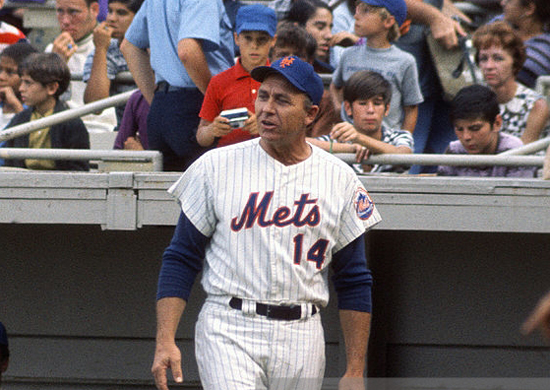
To Gil Hodges, it didn’t matter that the Mets were in a pennant race for the first time in their history. It didn’t matter that Cleon Jones was an All-Star. It didn’t matter that he was our best hitter. The Mets skipper would not sit idly by tolerating lackadaisical play. Hodges, stoic as always, stepped from the dugout, took a lengthy slow walk to left field and conferred with his star hitter. After a few words, Hodges turned and walked off the field. Cleon, like a chastised little boy, shadowed Hodges into the dugout.
Years later, Jones claimed he advised Hodges the turf was wet. Hodges replied there must be something wrong with his ankle and pulled him from the game. “Gil was my favorite manager I ever played for,” Cleon clarified years later. “He’d never embarrass a player that way.” We may never know the true content of the conversation. However, the implication was undeniable. This was Gil Hodges’ team. You either play hard or you don’t play. The Mets lost the nightcap, 11-5. They wouldn’t lose too many more.
Hodges’ club played .780, winning 39 of the last 50 games and capturing the division by 8 games. Cleon ended up hitting 340, third behind Pete Rose and Roberto Clemente.
In the first ever NLCS, the Mets swept the Braves. Cleon hit 429.
In the World Series few gave the Mets any chance of defeating the mighty Baltimore Orioles. And when Don Buford opened the Fall Classic with a HR off 25-game winner Tom Seaver, it appeared we were out of Miracles.
The Mets tied the series when Jerry Koosman outdueled Dave McNally 2-1. Back in New York for game three, the Mets drew first blood. Tommie Agee opened the game with a HR. He also made not one but two of the greatest catches in history. Gary Gentry outpitched future Hall of Famer Jim Palmer for a 5-0 Mets win. In game 4, Seaver returned to form. After struggling in the opener, Tom Terrific threw 10 innings, the Mets prevailed 2-1 and were now one win away from a championship.
The Orioles, however, showed why they won 109 games. Needing a win to return the series to Baltimore, they scored early off Koosman and took a 3-0 lead. In the top of the 6th, Kooz delivered an inside pitch. Frank Robinson claimed the pitch hit him. Home plate umpire Lou DiMuro disagreed. Replays clearly showed DiMuro blew the call.
Lightning struck again in the bottom of that same inning. And once again, Cleon was in the center of it. McNally threw a pitch low. Cleon danced out of the way, the ball ricocheted into the Mets dugout. Cleon, like Robinson, claimed the ball hit him. DiMuro claimed it did not. Gil Hodges ever-so-slowly walked onto the field and presented a ball with shoe polish to the umpire. DiMuro changed the call and awarded Cleon First Base. Seconds later, Donn Clendenon deposited McNally’s offering beyond the LF auxiliary scoreboard to cut the lead to 3-2. And one hour after that, Cleon caught that fly ball and dropped to one knee.
In the late 60’s/early 70’s, pitching dominated the game, especially in the NL. Bob Gibson, Steve Carlton, Juan Marichal, Gaylord Perry, Don Sutton and Phil Niekro, all future inductees in Cooperstown, quieted NL bats. But don’t tell that to Cleon. From 68-71 Cleon averaged 308.
The 1973 NL East was a dogfight of mediocrity. On August 30th, the Mets were in last place, but just 6 ½ back with 30 games remaining. Just like 1969, the Mets got hot at the right time. By September 17th, the Mets inched up to 4th, were just 3 ½ GB of Pittsburgh—with the Mets and Pirates playing a rare 5-game series–2 in Pittsburgh, 3 in New York. The two contests at Three Rivers were split and the series moved to Shea for three crucial games.
The Mets captured the opener, 7-3, and for only the second time in his career, Cleon went deep twice in one game. The lead was trimmed to a game a half. The following day, September 20th, one of the strangest yet most memorable play in team history occurred. And once again, Cleon was in the center of it.
Jerry Koosman faced off against Jim Rooker. A Mets victory would bring us to within a half, a loss would shove us 2 ½ back with just 9 games remaining. It was a back-and-forth contest. Pittsburgh took a 1-0 lead in the 4th. The Mets tied it in the bottom of the 6th. Pittsburgh took a 2-1 lead in the top of the 7th. The Mets tied it in the bottom of the 8th. Pittsburgh scored 1 in the top of the 9th to go up 3-2. The Mets tied it in the bottom of the 9th.
In the top of the 13th, Richie Zisk singled with one out. Pinch Hitter Dave Augustine came up and sent the Ray Sadecki pitch into the night. Cleon turned and ran…and ran…and ran some more. The ball did not go over. Nor did it bounce off the wall. It bounced on top of the wall. Cleon played the carom perfectly, pivoted and fired to relay man Wayne Garrett who turned and threw a bullet to catcher Ron Hodges who applied the tag to keep the game deadlocked at 3-3. In the bottom half of the inning, the Mets won, First place and the post-season was now within our grasp.
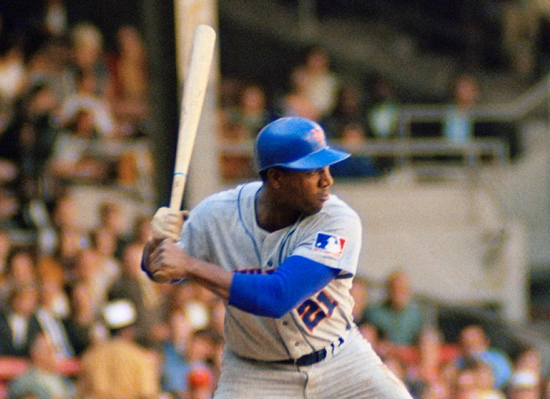
In the 1973 League Championship Series against the Big Red Machine, Cleon batted .300, 6-for-20 with three RBI and three runs scored. In the World Series against Oakland, Cleon hit .286. Of his eight hits, three were for extra bases. He scored five runs in seven games.
In 1975, it would all come crashing down like a Shakespearean tragedy. Spring training saw Cleon suffer a knee injury. He stayed behind when the team went north. On the morning of May 4 in St. Petersburg, FL, Cleon was arrested at 5:00 am. The charge? Indecent exposure.
Police found the 33 year-old sleeping inside a van next to a 21 year-old female who was in possession of marijuana. Cleon insisted he didn’t know the woman, that he met her at a party and was giving her a ride home when the van ran out of gas and he fell asleep. Ultimately, the charges were dropped. “Indecent exposure” was the fact Cleon was barefoot. However, in the eyes of Mets chairman M. Donald Grant this was inexcusable debauchery.
Grant was an autocrat, a tyrant who viewed his players as chattel. He once relinquished his membership to an exclusive Connecticut country club when he learned an inferior individual named Tom Seaver was also a member.
Grant fined Cleon $2000, four times more than any other player had ever been fined. Worse than the financial punishment was the degradation imposed on the Mets superstar. In the glare of the media, with cameras recording every mannerism, spotlights bathing him in a stifling glow and situated behind a bank of microphones angled like missiles about to launch, Cleon was ordered to apologize—to fans, to teammates, to his employer. And to his wife, Angela, who Grant insisted appear at his side.
In October 1969, Cleon caught a fly ball and cemented a miracle. It was the highest point in Mets history. Now, less than six years later, Cleon was again in the center, but this time it was the lowest point in Mets history.
He returned to the team in late May. But was not welcomed back. As if the financial punishment and humiliation were not enough, the order had come down from management that Cleon was to only play sparingly. For two months, the Mets icon was largely relegated to riding the pine. He seldom started and was used meagerly as a pinch-hitter. Such sparse play inhibited his ability to get any timing, extra burdensome knowing he was notoriously streaky. In July Cleon reached his breaking point. Hitting only 240 he got into an altercation with manager Yogi Berra. Grant now had more ammo and fired the fatal bullet. After 13 seasons, he was released outright.
The following year, 1976, he played for the White Sox but Cleon, a slow-starter, was hitting just 200 and promptly released. Cleon Jones, loved and adored by fans in New York, a World Champion, an All-Star, an almost Rookie of the Year and almost batting champion, was unwanted by any club. He was shamed out of Baseball by age 33.
For those of us lucky enough to have seen him play, he was the one that made you sit a little closer to the TV, move up onto the edge of your seat at Shea and chant Lets Go Mets a little louder. He was the one you always made sure to watch when he stepped to the plate, the one guy you wanted to get to in the batting order if you were trailing. He was flashy without being flashy.
It’s been nearly forty years since Cleon wore a Mets uniform. He played in a time when pitching dominated the game. And despite the fact that names like Strawberry, Hernandez, Piazza, Carter, Wright, Ventura and Reyes came after him, Cleon Jones still remains near the top in runs, hits, doubles and RBI’s.
In July 1969, he was involved in a play that turned around the season. In October 1969, he was involved in at-bat that opened the door to the Mets comeback in Game Five. In 1973, he was involved in one of the most famous, most strange plays in history, yet another turning point that led to yet another pennant.
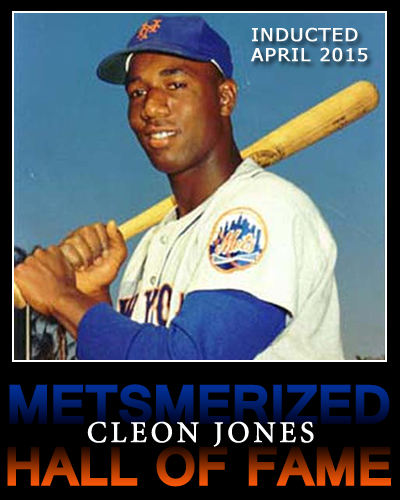
And with that, Metsmerized Online is pleased to announce that Cleon Jones is this year’s inductee into the Metsmerized Hall of Fame.
Jones now joins mike Piazza, Tom Seaver, Keith Hernandez, Jerry Koosman, Dwight Gooden and David Wright in our own hallowed halls honoring the best players the Mets ever had. Congratulations, Cleon!
Feel free to leave your best memories and most heartfelt recollections of Cleon in our comment threads.








